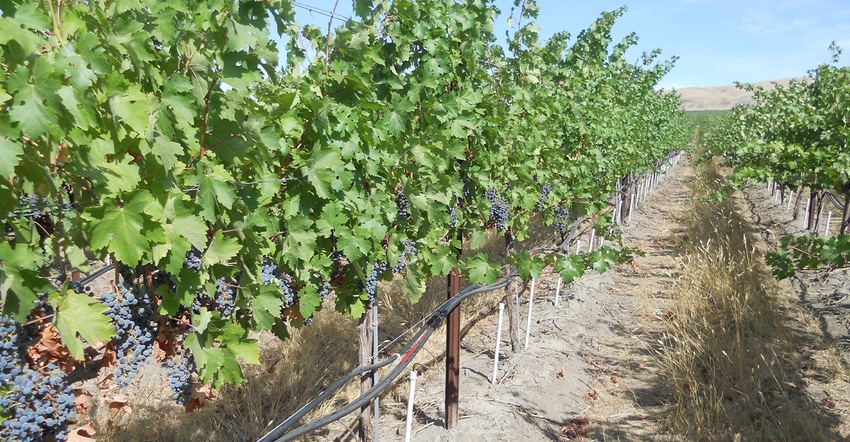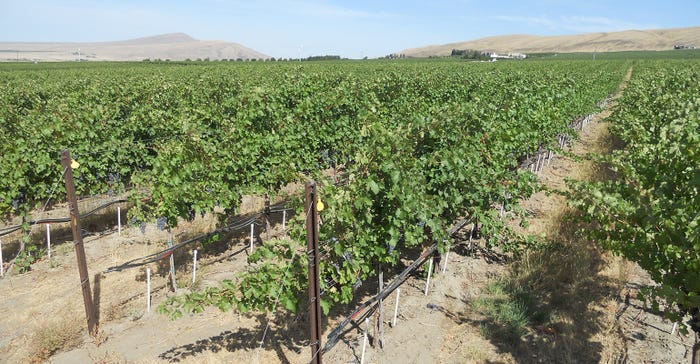November 12, 2019

The semiarid environment of the West Coast produces excellent winegrapes. In Washington state, more than 1,000 wineries produce at least 70 winegrape varieties. Most of these vineyards are in the state’s arid steppe climate, with an average of 7 inches of annual precipitation.
The lack of rain requires irrigation for the winegrape vines to flourish. Subsurface drip irrigation can reduce water use while maintaining the winegrapes’ yield and improving their quality. But is there room for improvement?
Pete Jacoby, a professor and plant ecologist in Washington State University’s Department of Crop and Soil Sciences in Pullman, Wash., speculated that an improved irrigation system design could save water, and thus money, without lowering winegrape quality. Jacoby initiated a three-year study through which he invented a new irrigation system, the direct root-zone.
The DRZ system efficiently delivers water below the ground directly to the vines’ roots. It also decreases the amount of irrigation water applied in a vineyard by 35%, without decreasing yield. “Additionally, we found that it improved winegrape quality,” Jacoby says of the research findings.
Subsurface challenges
Subsurface and surface drip irrigation are efficient irrigation methods. In surface drip systems, water trickles from hoses suspended from the trellis line. Subsurface systems currently on the market deliver water beneath the soil surface through buried drip lines. Both methods irrigate the surface soil around the vine. This benefits surface vegetation, such as invasive plant species, however, and their growth competes with the vine.
The commercially available subsurface systems often frustrate growers. “Many growers resist subsurface irrigation systems,” Jacoby explains, “because they’ve heard about it, or tried it themselves, and encountered problems.” He says growers need other irrigation options.
Jacoby wanted to solve previous subsurface challenges and reduce water use.
Two commercial growers each provided more than an acre of their respective vineyards for the WSU project. WSU researchers focused on water delivery to the vine root zone of 8-year-old cabernet sauvignon grapes during the 2015-17 growing seasons. One location was Kiona Vineyards, in the Red Mountain American Viticultural Area (AVA), near Benton City, Wash.

BIG PICTURE: This is an overview look at a 1.2-acre study plot in a cabernet sauvignon vineyard at Kiona Vineyards, Block 2, Red Mountain AVA, near Benton City, Wash.

Jacoby and his team inserted water delivery tubes directly to the root zone of different vines at 1-foot, 2-foot and 3-foot depths. “For [the DRZ] system, we don’t bury anything,” he says. Jacoby explains the difference between DRZ and buried drip lines: “We drill a delivery tube down, either side of the plant, and deliver the water directly through that. None of the system is actually in contact with the soil, other than the tube through which water is released underground.
“So far, we have not seen a real advantage of any particular depth over another,” Jacoby says of water delivery to the root zone. “But for the last three years, we’ve put the tubes down at a 2-foot depth. This reduces evaporation and creates a dry zone on the soil surface to reduce weeds and surface evaporation.”
In the study, Jacoby also lessened irrigation to the vines. “I didn’t know where to start,” Jacoby comments. “So, I guessed and put out three rates of water at three different delivery tube depths. I had nervous moments that the plants would die.”
The first rate tested was 60% less than the surface drip system. Then, Jacoby cut that in half to 30% (70% below the normal water application). He slashed that again to 15% (85% less than normal). “Surprisingly, we still got 70% of normal [winegrape] yield,” Jacoby says of the 15%. "I think 15% is way too little, though. In some of my treatments, particularly where I put in the tubes at only 1-foot depths, the plants were really stressed. Some of the grapes shriveled. It looked like I was growing raisins rather than grapes.”
Now, the lowest water rate that Jacoby applies is 60% less than normal surface application. He expects that optimal water application for grape yield and quality through the DRZ system will range from 60% to 40% of surface irrigation rates. “We find that grape quality increasingly improved as we put less water on the vines,” Jacoby says, “because of beneficial stress to the plant system.”
Designed to solve
The design of the DRZ system eliminates previous subsurface irrigation challenges. The pressure-compensated emitters are inserted directly into the delivery line on the trellis. This avoids emitters becoming clogged by soil when buried. The emitter in the trellis line dribbles half a gallon of water an hour down the tube inserted 2 feet into the vine root zone. This creates a dry zone on the soil surface at the base of the vine, which reduces weed competition.
Deficit irrigation balances vegetative and reproductive growth with fruit quality and yield. “It is difficult to successfully practice deficit irrigation with a surface drip system,” Jacoby says. “When water application is reduced after the fruit sets, the surface vegetation uses some of the water. Evaporation loss decreases it more — particularly in our area, where we get up to 100 degrees [F] or more in the summer.” The DRZ system enables precise deficit irrigation by delivering water 2 feet below the surface.
Through the DRZ system, gravity pulls water from the emitters down rigid PVC pipes inserted into the ground at the base of each vine. PVC is too thick for burrowing rodents to chew. Additionally, the rodents do not chew into the pipes because they don’t hold water. “We attach a quarter-inch spaghetti hose from the emitter [on the trellis line] and run it down to a cap on the PVC tube,” Jacoby explains regarding the design.
Deeply inserting the pipe into the ground encourages the vine roots to grow downward. “Grapes lose a lot of root biomass each year,” and then invest the carbon they absorb in growing new roots,” he says. “We inserted glass tubes into the root zone for a camera to actually monitor what’s going on down there. We find the DRZ system encourages the root system to grow deeper each year. Through this process, plants become less susceptible to drought impacts.”
The DRZ system, with rates at 80% or 60% of surface drip, maintained winegrape yields at or above commercial levels during the past three growing seasons. Jacoby and his team now determine the degree that DRZ retains soil nutrients in the root zone. Research will measure the DRZ against other subsurface and surface drip irrigation systems.
Another benefit of the DRZ design is that drilling the boreholes for the PVC pipes doesn’t disturb the vine roots. “[To install it] in an older vineyard with big plants, you only need to drill holes for the DRZ delivery tubes and attach a new water line,” Jacoby says.
Going to market
Jacoby built the DRZ from off-the-shelf parts. He now works with the WSU commercialization department to move the system toward commercial availability and out to growers.
“Unfortunately, I haven’t found funding for an economic study of the DRZ,” Jacoby says. “I’m unable to estimate cost of the system without that data of scale. Typically, though, there are 800 plants per acre. There are two units [emitter, delivery tube, etc.] per plant. Then, there’s the labor of drilling them in. If we can get the product out there for growers to buy, they can choose to install it either in existing vineyards or when they establish a new planting.
“My original goal [of this study] was to save growers water,” Jacoby continues. “It wasn't to patent a new system! That’s come later.” Through their research, Jacoby, his team, and partnering growers head toward revolutionizing vineyard irrigation.
Hemken writes from Lander, Wyo.
About the Author(s)
You May Also Like




